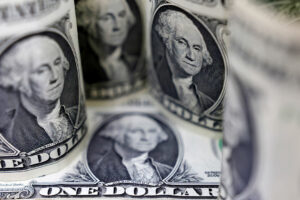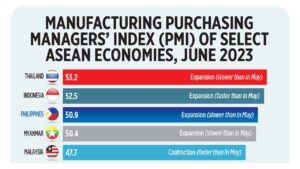Dollar reserves slip below $100B anew

By Keisha B. Ta-asan, Reporter
THE PHILIPPINES’ gross international reserves (GIR) slipped below $100 billion for the first time in four months, as the National Government paid its foreign debt obligations and the central bank adjusted the valuation of its gold holdings.
Data from the Bangko Sentral ng Pilipinas (BSP) released late on Friday showed the foreign exchange buffers slipped by 0.8% to $99.8 billion as of end-June from $100.6 billion as of end-May.
Year on year, the dollar reserves dropped by 1% from the $100.85-billion level a year ago.
This was the first time GIR fell below the $100-billion level since end-February when it stood at $98.22 billion.
“The month-on-month decrease in the GIR level reflected mainly the National Government’s net foreign currency withdrawals from its deposits with the BSP to settle its foreign currency debt obligations and pay for its various expenditures,” the BSP said in a statement.
The BSP also attributed the lower dollar reserves to the drop in the value of its gold holdings as prices fell in the world market.
Ample foreign exchange buffers protect the economy from market volatility and ensure the country can pay its debts in case of an economic downturn.
The end-June dollar reserves were enough to cover about 5.9 times the country’s short-term external debt based on original maturity and 4.2 times based on residual maturity.
It was also equivalent to 7.6 months’ worth of imports of goods and payments of services and primary income, the BSP said.
“The lower level of reserves can be traced to settlement of foreign borrowings plus revaluation of both gold and holdings of foreign investments, most likely US Treasuries,” ING Bank N.V. Manila Senior Economist Nicholas Antonio T. Mapa said in a Viber message.
Gains from investments abroad, which made up the bulk of the GIR, dipped by 0.8% to $84.05 billion from $84.76 billion a month ago and by 0.7% from $84.7 billion a year earlier.
In a note, Rizal Commercial Banking Corp. Chief Economist Michael L. Ricafort said the drop in foreign investments was due to the slump in the global bond markets in June.
In June, US President Joseph R. Biden, Jr. signed a law lifting the debt ceiling just two days before the deadline, averting what would have been the country’s first-ever default.
“(This) allowed more US government borrowings that increased the supply of US government bonds/Treasuries that led to higher US Treasury yields (lower prices of US government bonds/Treasuries),” Mr. Ricafort said.
He also noted gold prices in the world market fell by 2.2% month on month in June.
Gold reserves were valued at $10.01 billion as of end-June, down by 1.9% from the $10.2 billion as of end-May but 12% higher than the $8.94 billion a year earlier.
Meanwhile, foreign currency deposits reached $1.17 billion, jumping by 7.3% from the $1.09 billion as of end-May. However, this was a 56.9% decline from the $2.72-billion level as of end-June 2022.
Net international reserves dipped by 0.8% to $99.8 billion at the end of June from $100.6 billion a month earlier, the BSP said.
Net international reserves are the difference between the central bank’s reserve assets and reserve liabilities such as short-term foreign debt, and credit and loans from the International Monetary Fund (IMF).
Special drawing rights, or the amount the country can tap from the IMF, remained at $3.75 billion for the second straight month. It inched up by 0.2% from $3.74 billion last year.
Meanwhile, buffers kept with the IMF slipped by 0.3% to $794.5 million from $797.2 million as of end-May but rose by 5.1% from $755.8 million a year earlier.
“Despite outsized concerns about the Philippines running out of GIR, reserve cover remains more than adequate at more than seven months while GIR’s ability to cover short-term liabilities remains at more than five times over,” Mr. Mapa said.
He was referring to concerns over the BSP’s use of dollar reserves to temper the volatility in the foreign exchange market.
This, as the US Federal Reserve may still further tighten policy rates before yearend, which may lead to a narrower interest rate differential with the Philippines.
Earlier in June, the US Federal Reserve paused for the first time after hiking policy rates by 500 basis points (bps) since March 2022. The Fed funds rate currently stands at 5-5.25%. However, markets expect the US central bank to hike rates by 50 bps more before the year ends.
The BSP extended its policy pause for a second straight meeting in June, keeping the key rate at 6.25%. Since May 2022, the BSP has raised borrowing costs by 425 bps.
“For the coming months, the country’s GIR could still be supported by the continued growth in the country’s structural inflows,” Mr. Ricafort said.
The BSP expects dollar reserves to hit $100 billion by yearend.




